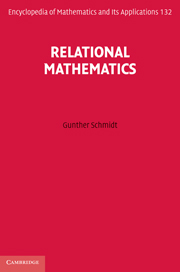Book contents
- Frontmatter
- Contents
- Notes on illustrations
- Preface
- 1 Introduction
- PART I REPRESENTATIONS OF RELATIONS
- PART II OPERATIONS AND CONSTRUCTIONS
- PART III ALGEBRA
- PART IV APPLICATIONS
- PART V ADVANCED TOPICS
- Appendix A Notation
- Appendix B Proofs postponed from Part II
- Appendix C Algebraic visualization
- Appendix D Historical annotations
- References
- Symbols
- Index
PART I - REPRESENTATIONS OF RELATIONS
Published online by Cambridge University Press: 05 May 2013
- Frontmatter
- Contents
- Notes on illustrations
- Preface
- 1 Introduction
- PART I REPRESENTATIONS OF RELATIONS
- PART II OPERATIONS AND CONSTRUCTIONS
- PART III ALGEBRA
- PART IV APPLICATIONS
- PART V ADVANCED TOPICS
- Appendix A Notation
- Appendix B Proofs postponed from Part II
- Appendix C Algebraic visualization
- Appendix D Historical annotations
- References
- Symbols
- Index
Summary
Part I starts by recalling more or less trivial facts on sets, their elements or subsets, and relations between them. It is rather sketchy and will probably be uninteresting for literate scientists such as mathematicians and/or logicians.
Sets, elements, subsets, and relations can be represented in different ways. We will give hints to the programmer how to work with concrete relations and put particular emphasis on methods for switching from one form to another. Such transitions may be achieved on the representation level; they may, however, also touch a higher relation-algebraic level which we hide at this early stage.
We are going to recall how a partition is presented, or a permutation. Permutations may lead to a different presentation of a set or of a relation on or between sets. Functions between sets may be given in various forms, as a table, as a list, or in some other form. A partition may reduce the problem size when factorizing according to it. We show how relations emerge. This may be simply by writing down a matrix, or by abstracting with a cut from a real-valued matrix. For testing purposes, the relation may be generated randomly.
There is a clash in attitudes and expectations between mathematicians and information engineers. While the first group is interested in reasoning about properties, the second aims at computing and evaluating around these properties and thus tries to have the relations in question in their hands.
- Type
- Chapter
- Information
- Relational Mathematics , pp. 3 - 4Publisher: Cambridge University PressPrint publication year: 2010

